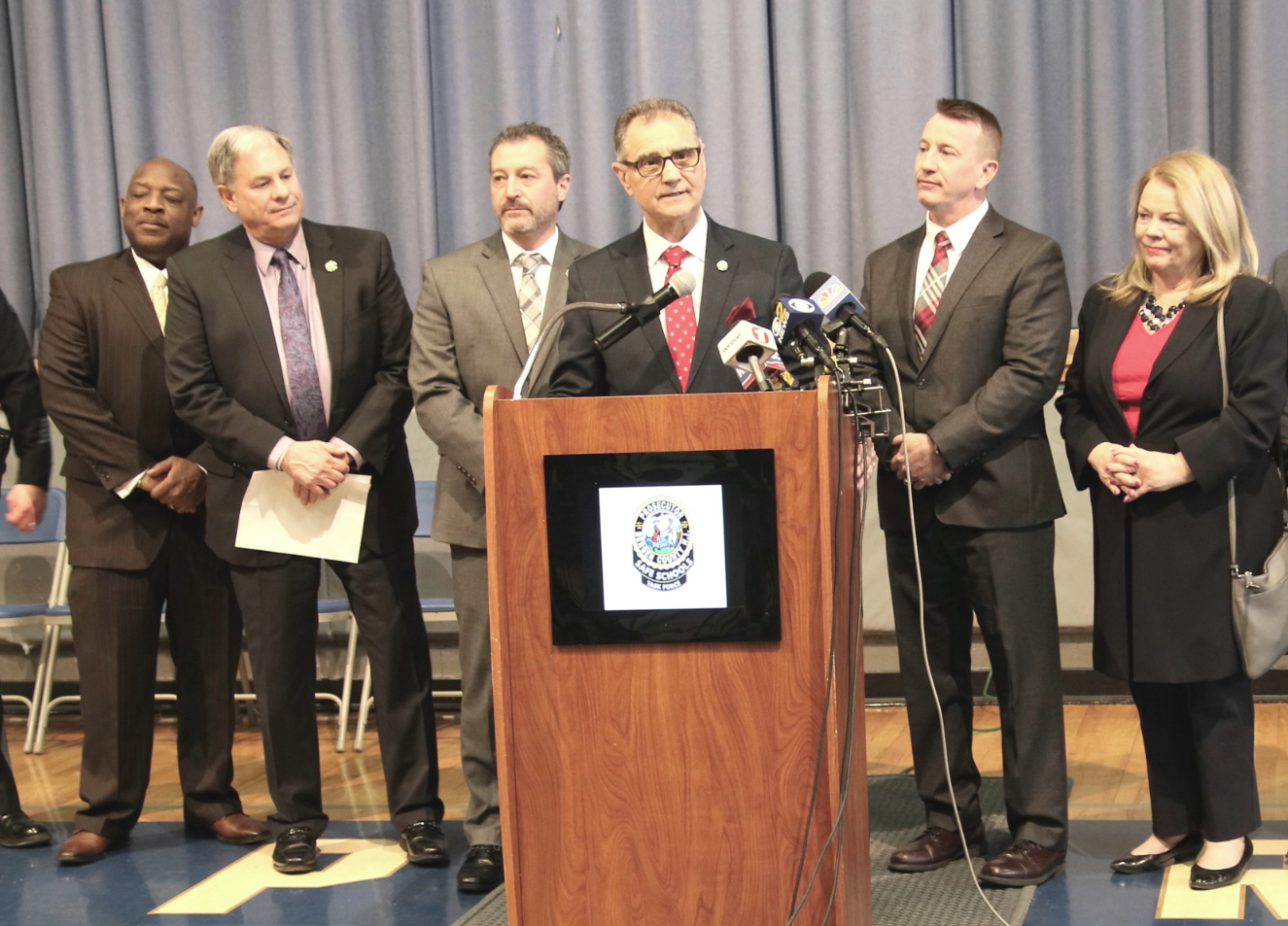
PARAMUS, N.J.—Over the past seven years he’s visited each of Bergen County’s 76 school districts, covering hundreds of public and private school buildings. Typically he arrives unannounced and is accompanied by the superintendent and local police officers.
You also might find him inspecting any one of hundreds of houses of worship throughout the county.
Moreover you might find him assessing buildings that comprise part of Bergen County’s critical infrastructure—wastewater treatment facilities, water treatment facilities, and other structures—to protect them from ever-evolving security threats.
He’s Agent William Stallone, a risk mitigation planner with the Bergen County Prosecutor’s Office (BCPO), and for 13 years he’s met thousands of residents, public and school officials, private individuals, employers, parents, and students.
We asked Stallone recently about the state of safety and security in Bergen County schools—particularly given his contribution to the Bergen County Safe Schools Task Force (SSTF), which reported out in March—and how towns, law enforcement, and school communities can work together this summer to save lives in fall and beyond.
Schools since Sandy Hook
Following the Sandy Hook Elementary School shooting in Newtown, Conn. in late 2012, Stallone has focused much of his efforts on helping school officials assess and mitigate areas of vulnerability and reduce threats to school safety and security.
Stallone said he goes wherever he’s requested to go—if a school superintendent or district needs him to do a security assessment, he said he’s there.
He said within a short period after the Sandy Hook massacre—20 children and six adults were murdered—the prosecutor’s office had him visit every county school district. He assessed 187 buildings for safety in short order.
Stallone offers a course on physical security training via the SSTF that highlights common and uncommon areas of security vulnerability.
The task force issued a 24-page report in March that highlights school security recommendations, emphasizing school officials and staff should take its three training courses to prepare adequately for future school security threats.
As part of the task force, Stallone teaches “Facility Security: Identifying and Remediating Common Safety Vulnerabilities.”
Some of these vulnerabilities “are found far too often,” he said: overgrown shrubbery concealing windows, unsecured electrical panels, and unlocked roof access hatches.
“Most vulnerabilities exist because school personnel do not recognize them as potential security hazards. Our training will help school personnel identify the problems and offer realistic suggestions to remedy them. Finally, this training strongly emphasizes the need for a comprehensive security policy and strict adherence,” Stallone said.
He said the purpose of making unannounced school visits—and requesting the school authorities to initiate their lockdown process—is to see where school vulnerabilities exist in real time and what needs to be improved to better protect students and school personnel.
Three bedrock principles
Stallone’s efforts, which include performing a security vulnerability assessment of a school’s perimeter and layout, are focused on three bedrock principles of school security: deter an attack, delay an attack, and defend against an attack.
Stallone said he finds “a lot of common vulnerabilities in schools” that he points out in a detailed written assessment he conducts on school facilities.
He presents security options and upgrades to school officials for review and implementation.
‘Safe School’ program
When we asked about the comprehensive approach for certification as a Bergen County Safe School—listed in the Safe Schools Task Force report—he said those standards are ongoing and will be fully developed and soon rolled out by a task force Accreditation Committee.
The report cites “minimum standards” in four key areas for accreditation including emergency response and communications; strategic staffing and partnerships; professional development and training; and building management and access control.
Stallone said partnerships with municipal police departments are critical to implement and follow-up on school security assessments.
He said continued follow-up by local police makes the difference in effective school security.
“School security is constantly evolving,” he said, referring to information learned from new school shootings that must be incorporated to stay ahead of security threats.
He said the BCPO works closely with the county Association of School Security Professionals as well as Bergen County Association of School Administrators and the Bergen County Police Chiefs Association.
Stallone emphasized that efforts to improve security are collaborative among county law enforcement, municipal police departments, and school officials.
Once a school district has a facilities assessment in hand, Stallone said, it’s in a better position to prioritize security improvements and identify funding, which can come in the form of federal and state grants.
He said later this summer or fall funding might be available from a portion of $350 million set aside in the state Securing Our Children’s Future Bond Act, which is collecting public input to help determine statewide school security priorities.
Some Bond Act funds can be used to pay for or pay back costs for installing silent panic alarms in elementary and secondary schools.
That’s part of Alyssa’s Law, signed by Gov. Phil Murphy in March: the law named for Alyssa Alhadeff, a 14-year-old former Woodcliff Lake resident shot 10 times and killed during the massacre at Marjory Stoneman Douglas High School in Florida in February 2018.
Another funding option may be grant programs offered by Community Oriented Policing Services (COPS), a U.S. Department of Justice program, including School Violence Prevention Program and Law Enforcement Mental Health and Wellness Act.
Though both grant program deadlines have expired for 2019, violence prevention grants provide 75 percent funding for security measures such as violence prevention staff trainings, metal detectors, locks, lighting, expedited law enforcement notification systems, and violence deterrence measures that can boost school security.
These include reporting systems such as hotlines, websites and mobile apps; mental health crisis training and anti-violence training.
Stallone said he always tries to alert districts to grant opportunities though many districts have hired grant writers who track and apply for such grants.
Facility security detailed
In its report, SSTF lists 27 components critical for facility security, including digital mapping of all school buildings, labeling of doors, installation of closed circuit television, coordination of school security with fire and building code officials; equipping classes with stay/shelter kits, a school lockdown protocol, and door and window locking mechanisms and procedures for limiting student and staff exposure.
Stallone said the three task force trainings—on facility security, mental health, and active-shooter response—alert school officials to report back suspicious activity.
“That’s critical to preventing or mitigating an incident,” he said.
He noted the knowledge of warning signs for potential violence of suspicious activity was similar to a “bumping contest”— as when a shark brushes against potential prey before striking.
He said if school officials and staff know the warning signs—whether it’s in building security, mental health issues, or active-shooter situations, such awareness can make the difference in keeping students secure and alerting authorities.
In addition to facilities security assessments, a BCPO spokeswoman said the county is piloting a mobile app called LiveSafe to provide anonymous reporting of suspicious activity in up to five communities, with rollout eyed for September.

